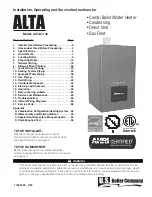
19
Table 9: Flow and Pressure Drop at a Given Temperature
Rise (DR1200-5000)
Model
20
o
F Rise
25
o
F Rise
30
o
F Rise*
US GPM
∆P-Ft.
US GPM
∆P-Ft.
US GPM
∆P-Ft.
1200
113.8
10.0
91.0
6.6
75.8
4.7
1400
132.8
14.0
106.2
9.2
88.5
6.5
1600
151.8
14.1
121.4
9.3
101.2
6.5
1800
170.9
14.3
136.7
9.4
113.8
6.7
2000
189.8
20.8
151.8
13.6
126.4
9.7
2500
237.2
27.1
189.8
17.7
158.0
12.5
3000
284.6
27.3
227.7
17.8
189.6
12.7
3500
331.8
33.0
265.4
21.5
221.2
15.3
4000
379.5
36.9
303.6
24.0
253.0
17.1
4500
426.9
55.8
341.5
36.3
284.6
25.6
5000
474.0
60.0
379.2
39.0
316.0
27.5
∗
Use for hydronic heating applications only
4.8
WATER FLOW SWITCH
A water flow switch is mounted and installed in the outlet piping
on all heating boilers and hot water supply boilers. The flow
switch is wired in series with the 24VAC safety control circuit.
4.9
LOW WATER CUTOFF (If Equipped)
If this boiler is installed above radiation level, a low water cut-
off device must be installed at the time of boiler installation.
Some local codes require the installation of a low water cut-off
on all systems. Electronic low water cut-offs are available as a
factory supplied option on all models. Low water cut-offs
should be tested every six months, including flushing of float
types. The normally open switch contact of the low water cutoff
is to be wired in series with the flow switch. A red diagnostic
light will be indicated on the control display on a low flow
condition.
Caution: remove jumper when connecting to 24 VAC circuit.
Figure 19: Low Water Cut Off Electrical Connections (Watts)
Figure 20: Low Water Cut Off Electrical Connections (ITT)
4.10
RELIEF VALVE
This appliance is supplied with a relief valve sized in
accordance with ASME Boiler and Pressure Vessel Code,
Section IV (“Heating Boilers”). The relief valve is installed
or shipped loose and is installed in the vertical position
and mounted in the hot water outlet. No valve is to be
placed between the relief valve, and the appliance. To
prevent water damage, the discharge from the relief valve
shall be piped to a suitable floor drain for disposal when
relief occurs. No reducing couplings or other restrictions
shall be installed in the discharge line. The discharge line
shall allow complete drainage of the valve and line. Relief
valves should be manually operated at least once a year.
If a relief valve discharges periodically, this may be due to
thermal expansion in a closed water supply system.
Contact the water supplier or local plumbing inspector on
how to correct this situation. Do not plug the relief valve.
CAUTION
Avoid contact with hot discharge water
4.11
CIRCULATING PUMP SELECTION
The appliance has a low mass stainless steel finned tube
heat exchanger for fast response and high heat
absorption. Selecting the proper pump will ensure that
temperature rise does not exceed the maximum
recommended for the application and that the heat
exchanger tubes are not prematurely scaled or eroded.
4.11.1
CIRCULATING PUMP OPERATION OF HEAT
EXCHANGER
MOST IMPORTANT
This appliance is designed for continuous pump operation
when the burner is firing. The pump control option allows
the appliance circulating pump to be cycled “ON” prior to
the burner firing and cycled “OFF” some time after the set
point is satisfied.
The operation of the circulating pump is controlled by the
Dynaforce® temperature control (SOLA). When the
appliance is activated by a remote operating signal the
pump will start and run for the operating cycle and for a
post purge period based on temperature difference
between inlet and outlet connections to the appliance. The
SOLA can directly operate pumps up to 1/6 HP. Larger
pumps will require a separate relay or contactor.
Connection detail for placing
L.W.C.O in 24V circuit
WARNING: Be sure to remove the
jumper between H and P1
Pressure Switch
From
Flow
Switch
To High Limit
Summary of Contents for DRH300
Page 2: ......
Page 6: ......
Page 38: ...32 13 Place toggle switch setting to REMOTE for remote operation if required...
Page 69: ...63 PART 12 EXPLODED VIEW 19 1 2 3 4 5 6 7 8 9 10 11 12 13 14 15 16 17 18 20...
Page 70: ...64 21 22 23 24 26 35 34 33 32 31 30 29 28 27 25 36 37 38 39 40 42 43 56...
Page 77: ...71 PART 13 ELECTRICAL DIAGRAMS...
Page 78: ...72...
Page 79: ...73...
Page 81: ...75...
Page 82: ...76...
Page 83: ...77...
Page 86: ......
















































